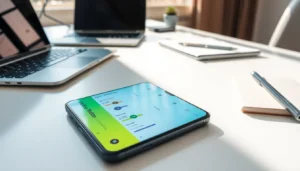iPhone users often rely on Screen Time to keep their digital habits in check, but what happens when that trusty feature decides to take a vacation? Picture this: you’re trying to limit your TikTok scrolling, but your iPhone’s Screen Time feature is about as reliable as a cat at a dog show. Frustrating, right?
Table of Contents
ToggleCommon Issues with iPhone Screen Time
Various factors impact the reliability of the Screen Time feature on iPhones. Understanding these common issues helps users troubleshoot effectively.
Software Glitches
Software glitches frequently disrupt how Screen Time tracks usage. These glitches can occur during updates or system changes. Restarting the device often resolves temporary bugs. Users may also consider resetting settings to restore functionality. Checking background app refresh settings might help fix tracking discrepancies. Keeping track of specific incidents can assist in identifying patterns leading to issues.
Outdated iOS Version
Outdated iOS versions often lead to Screen Time malfunctions. Using an earlier version can result in compatibility problems with various features. Updating the device ensures access to the latest features and bug fixes. Users can check for updates in the settings under General and Software Update. Installing the latest version not only improves performance but also enhances security. This proactive step significantly reduces the occurrence of tracking issues.
Troubleshooting Steps
Troubleshooting the Screen Time issue on iPhones involves several straightforward actions. Users can usually resolve common glitches quickly and effectively.
Restart Your iPhone
Restarting the iPhone can often resolve small software issues. Powering off the device clears temporary files and refreshes the system. To restart, press and hold the side button until the slider appears. Users then drag the slider to turn off the phone. After a minute, turning the device back on can help restore proper functionality of Screen Time.
Check Screen Time Settings
Examining the Screen Time settings is crucial for ensuring the feature operates correctly. Users should navigate to Settings, then tap Screen Time to verify the configuration. Confirming that Screen Time is enabled is essential. If restrictions are in place, users must ensure they have appropriate access. Adjusting settings for specific apps may also be necessary if some are improperly tracked. Regularly reviewing these options can lead to improved performance.
Alternative Solutions
iPhone users experiencing issues with the Screen Time feature can explore several alternative solutions to restore functionality.
Reset All Settings
Resetting all settings on an iPhone can resolve persistent Screen Time problems. This action restores the device to its default configurations without erasing personal data. Users access this option by navigating to Settings, then tapping General, followed by Reset, and selecting “Reset All Settings.” After confirming the selection, the iPhone will restart. Important settings, such as Wi-Fi passwords and wallpapers, may revert to original defaults. This process can eliminate software conflicts affecting Screen Time.
Update iOS Software
Updating the iOS software is crucial for resolving Screen Time issues. A current software version ensures compatibility and access to the latest features. Users should check for updates by opening Settings, selecting General, then tapping Software Update. If an update is available, following the prompts will complete the process. Regular software updates help reduce bugs and improve overall system performance, allowing for enhanced tracking within the Screen Time feature. Keeping the device updated also protects against security vulnerabilities that may arise from outdated software.
User Experiences and Feedback
Users frequently express frustration when Screen Time fails to work as expected. Issues such as inaccurate tracking lead to concerns about digital habits. Some report problems specifically with certain apps like TikTok, where the feature doesn’t capture usage correctly. These experiences often highlight the importance of reliable tracking for establishing healthy boundaries.
Many individuals find relief after restarting their devices. This simple troubleshooting step resolves minor glitches and refreshing connections. Verifying that Screen Time settings are enabled also proves crucial. Ensuring restrictions are active contributes to accurate tracking. Users frequently emphasize the value of checking configurations for particular apps that seem problematic.
Frustrations often arise after updating iOS, where new features sometimes introduce unexpected bugs. For instance, some users noticed Screen Time working inconsistently post-update. They report that accessing the official troubleshooting guides helps mitigate these issues. Resources provided by Apple serve as helpful references for resolving common problems.
Feedback also reveals the effectiveness of resetting all settings for persistent issues. It restores original configurations while preserving personal data. As a result, a significant number of users claim this method resolves complications around Screen Time.
Notably, users suggest keeping devices updated to minimize software conflicts. They recognize that regular updates deliver important security patches and overall system improvements. Emphasizing this aspect enhances the functionality of necessary features, making it essential for uninterrupted usage tracking.
Addressing the issues with iPhone Screen Time can significantly enhance users’ ability to manage their digital habits. By following the troubleshooting steps outlined in the article users can often restore functionality and improve their experience. Regularly updating iOS and reviewing settings ensures that the Screen Time feature operates smoothly and effectively.
For those still facing challenges it may be beneficial to consult Apple’s official support resources. Staying proactive in managing device settings not only helps with Screen Time but also contributes to overall device performance. With the right approach users can regain control over their screen time and enjoy a healthier relationship with their devices.

